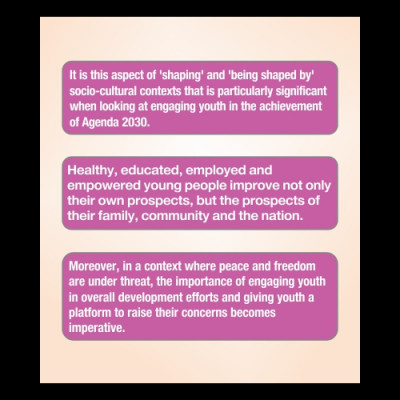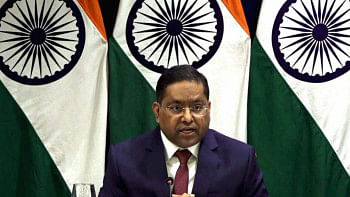Youth Leading Sustainability

The Road to 2030: Eradicating Poverty and Achieving Sustainable Production and Consumption', the theme of the 2016 International Youth Day, focuses on engaging youth in achieving the 2030 Agenda for Sustainable Development. The Agenda 2030 should be read as a powerful human rights statement that recognizes the centrality of empowering and enabling citizens, especially the most neglected: women and young people.
Highlighting goals 1 and 12, ending poverty in all its forms everywhere and ensuring sustainable consumption and production patterns respectively, the theme this year aims to underscore the inextricable link between poverty and sustainable consumption and production. Needless to say, the link between increased poverty, undernutrition and poor health, especially sexual and reproductive health, has been well researched and documented globally.
As a socially constructed category, it is not surprising that the definition of youth varies from context to context. Youth is a stage in life, which is often seen as being transitional from adolescence to adulthood, where the individuals are afforded greater privileges and rights but are still not considered adults. The United Nations defines youth as those between the ages of 15-24 years while in Bangladesh, youth are defined as those between the ages of 18-35 years. Regardless of how they are defined, or categorised, what is important is to acknowledge youth as active agents of their own right and as a force, which both shapes and is shaped by the socio-cultural context and structures.

* Youth must be empowered to claim their rights and to pursue their dreams and aspirations for their countries and for humanity.
* Child marriage, early and unintended pregnancies, poor access to health care, including sexual and reproductive health services, undernutrition, and gender discrimination undermine the development of millions of girls and women.
* Undernutrition remains a major challenge in Bangladesh with significant consequences for individuals, the economy and health systems, costing more than US$1 billion in lost productivity every year. The effects of this deprivation lasts a lifetime, leading to poor health, lower educational attainment and reduced productivity and earning potential.
* Youth must also benefit from favorable economic conditions and employment opportunities to contribute to economic development.
Bangladesh, with a youth population (those between the ages of 18-35 years) of nearly 52 million, can shape this population and in turn ensure they shape the development of Bangladesh.
Firstly, the country could target investments in the health, education, employment and skills development of its adolescents and youth, including technical and vocational education and training through formal and non-formal education. This entails ensuring adequate and gender responsive budgeting to specifically address the needs of Bangladesh's female youth population.
Secondly, the country needs to provide its youth with platforms to actively engage in the development of the country - to implement Agenda 2030, to monitor its progress and to voice their concerns. Similar to the example of the fledgling citizens' platform for monitoring SDGs, facilitated by the Centre for Policy Development, a platform could be established for the youth voice.
How can this be done?
In Bangladesh because youth make up such a large portion of the entire population their actions carry special weight. In an era of conspicuous consumption, it is important to develop and promote individual choices and actions, which increase efficiency of consumption for all and minimize waste and pollution. Youth need to be both educated and educate others on green consumption: the mantra reduce, reuse and recycle should be at the forefront of all our efforts to ensure sustainable consumption and production. If only the youth population of Bangladesh, that is nearly 52 million people, change their consumption patterns it can make a significant impact to the overall development of the country.
Changing production and consumption patterns also have the potential to contribute to the eradication of poverty - the first goal of Agenda 2030. Manifestations of poverty are multidimensional and include malnutrition, poor education, social discrimination and poor health, including sexual and reproductive health. Education is instrumental to moving out of poverty as evidenced by the fact that the incidence of poverty is six times higher among those with no education than those who have completed secondary and higher education. Nutrition, poverty, and living conditions in urban areas are interrelated with issues of education, social protection, and water and sanitation. This suggests a holistic approach to addressing how these various experiences intersect at this crucial stage of a person's life, which having a bearing on their experiences as they enter adolescence.

Reducing poverty among youth and, equally importantly, engaging them in all poverty reduction efforts in Bangladesh are but two direct ways in which we can provide youth with the platform to contribute to achieving the first goal of Agenda 2030.
Bangladesh currently faces a demographic window of opportunity, which can be turned into a demographic dividend - a boost in economic productivity due to growing numbers of people in the workforce relative to the number of dependents.
Repositioning Family Planning and Comprehensive Sexuality and Reproductive Education for the young will also galvanize efforts to end poverty. Evidence has shown that when families have fewer children they invest more in their education, increasing skills and thus human capital. Family members are also able to save more for their retirement and thus able to invest more. Moreover, if girls receive education and are empowered to seek employment the workforce grows leading to a boost in the economy. Taking a look at countries around the world, with few exceptions countries with lower fertility rates are richer than countries with high fertility rates. If the right investments are however not made within the next 10 years the demographic dividend cannot be achieved.
By placing youth at the centre of sustainable development, Bangladesh can move to be a torch bearer in living up to the spirit of a truly universal 2030 Development Agenda.
Poverty eradication and sustainable consumption and production are just two areas where youth can play an active role. They are however, areas which will have far reaching impact; not just on the youth themselves but also the overall development of the country. Let's celebrate the youth of today for what they have done and what they have the potential to do, to make Bangladesh a developed and peaceful nation!
This supplement has been written jointly by UNFPA, WFP, UNIC and UNESCO to mark International Youth Day, which gives an opportunity to celebrate youth views and initiatives, and is commemorated on August 12, subsequent to resolution 54/120 passed by the General Assembly in 1999.


 For all latest news, follow The Daily Star's Google News channel.
For all latest news, follow The Daily Star's Google News channel. 



Comments